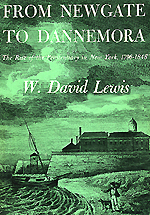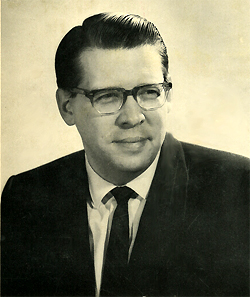xxx

xxx
NYCHS presents excerpts from From Newgate to Dannemora: The Rise of
the Penitentiary in New York, 1796-1848, by W. David Lewis.
Copyright © 1965 by Cornell University; copyright renewed 1993.
Used by permission of the author and the publisher, Cornell
University Press. All rights reserved. Click on image, based on book jacket front cover, to access Cornell University Press site.
|
|
FROM NEWGATE
TO DANNEMORA
The Rise of the Penitentiary in New York, 1796—1848
By W. David Lewis
CORNELL UNIVERSITY PRESS
Ithaca, New York
[Book jacket blurb text below:]
A significant chapter in the history of American social reform movements is traced in this skillful account of the rise of the New York penitentiary system at a time when the United States was winning international acclaim in the development of penal methods,
xxx

Image above, caption below from book jacket flap:W. David Lewis is Fellowship Coordinator of the Eleutherian Mills-Hagley Foundation in Wilmington, Delaware, and a Lecturer in History at the University of Delaware. He received his B. A. and M.A. degrees from Pennsylvania State University and his Ph. D. from Cornell University. He has previously held positions at Hamilton College, where he was Instructor in Public Speaking, and at Cornell, where he was a John L, Senior Fellow in American Studies.
|
|
Beginning with Newgate, an ill-fated institution built in New York City and named after the famous British prison, W. David Lewis describes the development of such well-known institutions as Auburn and Sing Sing, and ends with the establishment of Clinton Prison at Dannemora. In the process he analyzes the activities and motives of such penal reformers as Thomas Eddy, the Quaker merchant who was chiefly responsible for the founding of the penitentiary system in New York; Elam Lynds, whose unsparing use of the lash made him one of the most famous wardens in American history; and Eliza W. Farnham, who attempted to base the treatment of convicts upon the pseudo-science of phrenology.
|
[From Dedication page:]
To Carolyn and the Children
|
|
The history of the Auburn penal system -- copied throughout the world in the nineteenth century -- is the central topic of Lewis' study. Harsh and repressive discipline was the rule at Auburn; by night the inmates were kept in solitary confinement; by day they were compelled to maintain absolute silence while working together in penitentiary shops.
The proceeds of their labor were expected to cover the full cost of institutional maintenance; thus prison was seen as a kind of factory. Indeed, it became for a time a leading center of silk manufacture.
|
[From Copyright data page:] Copyright © 1965
by Cornell University
All rights reserved
CORNELL UNIVERSITY PRESS
First published 1965
Library of Congress Catalog Card Number: 64-8260
PRINTED IN THE
UNITED STATES OF AMERICA
BY VAIL-BALLOU PRESS, INC.
|
|
|
Table of Contents
|
- [Book jacket blurb, images]
- Preface
- The Heritage
- The First Experiment
- The Setting for a New Order
- The Auburn System and Its Champions
- Portrait of an Institution
- The House of Fear
- The Ordeal of the Unredeemables
- Prisons, Profits, and Protests
- A New Outlook
- Radicalism and Reaction
- Ebb Tide
- Change and Continuity
- A Critical Essay on Sources
|
|
Lewis demonstrates how the rise and decline of the Auburn system reflected broad social and intellectual trends during the period.
Conceived in the 1820s, a time of considerable public anxiety, the methods used at Auburn were seriously challenged twenty years later, when a feeling of social optimism was in the air.
The Auburn system survived the challenge, however, and its methods, only slightly modified, continued to be used in dealing with most of the state's adult criminals to the end of the century.
As the first extended treatment of American prison reform that takes into account the broader context of political, economic, and cultural trends current in the early national and Jacksonian periods, From Newgate To Dannemora will appeal not only to the students of penology, but also to everyone interested in American history and culture.
|
